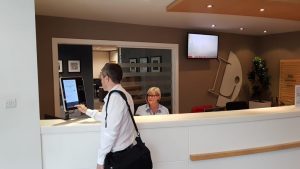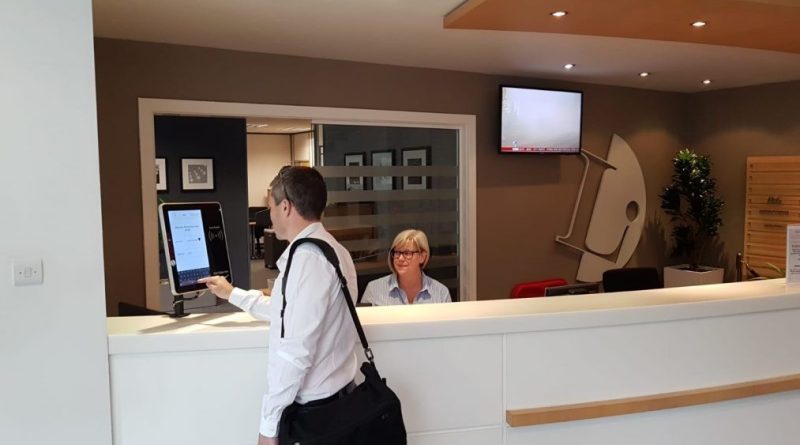Benefits of Secure Visitor Management

It is more important than ever to secure our workplaces in the quickly changing corporate environment of today. The necessity for strong and secure visitor management has become critical as businesses expand and take on more contractors, temporary employees, and guests. This thorough investigation explores how secure visitor management improves operational effectiveness, increases worker safety, and fosters a more formal atmosphere for all parties.
1.Creating a Secure First Impression: The Gateway to Workplace Safety
The entrance area of any building acts as much more than simply an opening – it is the first and foremost barrier in preserving workplace security. Whenever organisations put in place effective security measures for visitors, they automatically create a business-like environment that informs responses to security issues. This first encounter helps establish the rapport and builds up the organization’s security credo throughout the visit.
Security measures implemented at entry points include more than just restricting entry; they act psychologically on security threats. Whenever people undergo a structured receipt of the check-in process, the chances are high that they will have to autonomously adjust their behaviors and duties in that particular structure.
Also, a well-designed visitor management system assists in making a good impression with the employees because they can be assured that their workplace’s safety is valued. This sense of security, in one way or the other enhances job satisfaction and productivity for the workers since they don’t have to worry about people who are unauthorized to be in some specific area.
2.Streamlining Operations: The Efficiency Revolution in Access Control
Such approaches can only cause additional delays and increase the chances of making mistakes due to the use of the current visitor management tools: paper sign-in sheets and hand-written visitor tags. However, modern secure visitor management turns such practices into efficient processes that take much less time for the host and the guest. It’s not just convenient – it has clear business value where the company improves operations and utilises resources in a more effective way.
Automating the receiving of visitors does away with a number of tasks that used to require the attention of staff. In this regard, the assumed features, ranging from pre-registering the expected guests to automatically informing the host of the visitor’s presence, make life easier for both receptionists and security agents.
In addition to the actual time saving that comes from efficient permission management, there is a domino effect of organizational enhancements. When patients can get through admissions’ formalities with little hindrance, sessions and conferences begin as planned, supplies and orders arrive as arranged and construction crews can go to work.
3.Enhancing Compliance and Risk Management: The Legal Shield
As regulations continue to grow higher and the chances of high liability continue to rise, secure visitor management enhances compliance and shrinks organizational risk. From policies on the protection of personal data to guidelines on workplace virus safeguard, firms are required to show that they have done everything possible to safeguard people from the virus. Having a clear visitor management policy, along with the documentation and protocols required to implement it, means there are robust defenses to such motherhoods.
Effective systems for visitor management maintain records that serve as essential documentation in different situations: security breaches, compliance to set standards during audits. These records identify people who visited the centre, the time they came in, the individual they met and time the person left. What is especially important in such detailed documentation is that it can shield organizations from liability claims and assist in explaining visitor access or conduct.
With correct data management measures by means of safe visitor administration, organizations will guarantee that they are procuring relevant information only and guarantee the data is shielded effectively. The formatted compliance approach can help to avoid many violations and maintain a business’ reputation for professional data management.
4.Building Professional Relationships: The Customer Experience Factor
It’s, therefore, a function that prioritizes security as its main function while at the same time providing guests with the best experiences possible as a way of building professional reputation. A good visitor management system is reflective of organizational professionalism and the keeness that the organization pays to details, issues that determine business interactions and dealings. This professional outlook could be felt especially keenly in companies who often receive clients, investors or any other important personalities.
There is a mutual positive correlation between today’s VMS and a favorable reception, as well as security. The attendees like to know what to expect and feel that they are not wasting the time of the authorities on their account through bureaucratic procedures. Appointment making features enable organisations to organise themselves for the visitor prior to their arrival; thereby signifying courtesy towards the time of the visitor.
These systems can also make visitors have a unique experience the second time around or for VIPS the systems can make a note of what the visitors prefer and make things easier next time they visit.
5.Emergency Preparedness: The Safety Net
In crisis situations frequently, it is very important to know who is in your facility to avoid messy situations. Effective visitor management systems offer real time identification of occupancy within a facility when responding to an emergency. This capability comes in handy more often as organizations are faced with any form of emergent situations that may range from natural calamities to acts of terrorism.
During the evacuation the full list of people in the building including visitors, contractors, and employees is easily available for security personnel. It assists in taking statistics and importantly guarantees that none is overlooked. The system can also be useful with coordinating with the emergency response teams through the use of providing the correct details of the building occupancy as well as location of all visitors.
Other than the obvious critical mission of providing security in responding to emergencies, secure visitor management systems can facilitate analysis and enhancement of an organization’s emergency response.
Conclusion
The benefits of Dubai’s secure visitor management system extend far beyond basic access control, touching every aspect of organizational operations and relationships. As workplaces evolve and face new security challenges, the importance of professional visitor management will only grow. Organizations that embrace comprehensive visitor management solutions position themselves to meet current security needs while preparing for future challenges.

